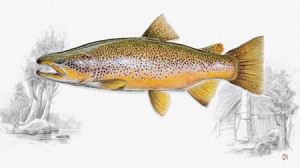Wild fisheries on the rise…
Over the past couple of seasons, mates and I have been exploring fisheries that barely see a person. We’ve explored the Mersey and Meander rivers from top to bottom, waded up and down the southern rivers and rainforests, and explored even more of the Western Lakes area. All of these fisheries are bucking the Australia-wide trend of disastrous impacts from drought and climate change, and have become a shining light in the future of the fisheries I work among.
The Mersey and Meander rivers in northern Tasmania now have legislated environmental flows for the first time in their histories; hatches are developing with vigour, the average size of the wild trout in these rivers is on the increase, and the fisheries themselves are becoming more consistent, and more predictable. Rainfall in these catchments has decreased, but better resource management has countered any effects, and the fisheries are beginning to achieve their potentials.
Down south there has been some positive flow-on effects from climate change. A decrease in annual rainfall throughout southern Tasmania has made the big rainforest rivers more accessible to wading and fishing, whilst pressure on the logging industry has led to increased public access to our forests, and our rivers. The excellent brown trout fisheries we’ve found along these river systems has raised more than a few eyebrows in surprise.
Equally, better environmental management along the Derwent River has led to the re-birth of another major fishery. Drastically improved environmental impact management from heavy industry along the urban sections of the river have seen remarkable changes such as whales swimming through Hobart, but more significantly for fly fishers, sea-run and resident trout populations have begun to flourish. Sight-fishing to large sea trout along the estuary and lower sections of river is now a year-round prospect, complete with annual ‘hatches’: lampreys, glass eels, crabs, isopods, amphipods and the whitebait runs all create feature hatch-driven fishing events.
And then there’s Tasmania’s perennial wilderness fishery, the World Heritage Listed Western Lakes region. This fishery thrives on seasonal wet and dry periods, fluctuations that inundate new ground, providing fresh flushes of food for the wild brown trout, and dry periods that restrict spawning and recruitment to headwater trophy fisheries. This fishery is as healthy as ever.
Thanks for letting us share the good news stories with you!
Now available: Fly Cards book by Daniel Hackett, and Western Lakes Limited Edition print
After three months of hard work, Fly Cards has arrived back from the printers this week. It’s been more than a decade since Australian’s have had a fly tying book of their own, and a lot has changed in that time: we’ve seen the beginnings of a generational change in in fly tying. Foam products are now an integral part of fly tying, U.V. reflective materials have opened up a new school of thinking, and the transplanting of British loch-style fly fishing techniques to Tasmania has lead to the development of our own specialised loch-style flies. In Fly Cards I was able to represent these new materials, techniques and styles, and also cover their origin and history. We hope that Fly Cards stands testament to the beginning of a new chapter in Australian fly tying history. Fly Cards is available now from our webshop
To create our Western Lakes artwork, our second new product for 2010, we commissioned third-generation Western Lakes fisherman Clifford How to capture the unique pencil pine’s of the plateau, and the historically important trapper’s huts that now provide shelter and inspiration to fly fishers. Inspiration for the pencil pines and dolerite scree depicted in the artwork came from those found on the islands of the Lunka Lake system. These island outcrops of centuries-old trees are testament to the fire protection that these lakes have provided since their glaciated inception. Junction Lake hut plays the role of muse for the cryptic trappers hut sketched in charcoal, complete with the ‘RRR’ branded timbers that represent the makers mark found on many huts in the area. The wild trout of the artwork is pictured with the vivid golds of the brown trout found in the region, a colour made ever more vibrant by a diet rich in shrimp and crustaceans.Western Lakes limited edition print is available now from our webshop.
Opening Day fishing report
Opening day in Tasmania was last weekend, with lots of reports coming in. I had a great day of guiding on the Derwent for fresh sea-run brown trout, an experience echoed by a lot of lure fishermen over the weekend. The current run is mainly 2-4lb trout, but larger fish will begin to follow the whitebait up the estuary within the next few weeks.
The South Esk is looking excellent after some cleansing winter floods, and is now running high and very clear. The Meander also had one good winter flood, and things are set up perfectly for the start of the late September, spring mayfly hatch. The upper Macquarie River (which began a recovery from drought last year) has featured high winter flows, and with one more good rain event, we should see the headwater dam (Tooms Lake) overflow and flood the river for the second year running. This is great news. Tooms Lake itself is fishing well.
In the Central Highlands, Penstock and Little Pine lagoons produced the best fishing for trout to 4lbs, whilst Great Lake was a bit slow off the mark. The Western Lakes are still frozen, with daytime temperatures peaking at a mere 2 degrees last weekend!
Mayfly Hatches and dry fly fishing – only 40 days, and counting…
With the season now underway, it’s less than 40 days (and counting) till the spring mayfly hatches and dry fly fishing gets underway. After a second consecutive wet winter, the northern rivers are looking primed for a big year of mayfly. Send us an Email if you would like to book in for a couple days break away from the city. For those pressed for time, we can pick you up from an early morning flight into Launceston, and drop you off for the late evening flight back to Melbourne or Sydney: tickets are often cheaper than the alternative cost of driving to the Snowy Mountain’s or North Eastern Victoria!
Custom Trout flies tied-to-order
Just a quick reminder to everyone that tied-to-order flies are available from our webshop. Orders are dispatching in 7-8 days currently. New patterns that I am tying include our MK2 Fuzzle Bugger, the Claret Dabbler, and The Earthworm.
That’s all for now. We hope you all have a great season in 2010/2011, and feel free to pass this newsletter on: word-of-mouth is the cornerstone of our successful business.
Thank you from the RiverFly Team – Daniel, Simone & Patrick.



